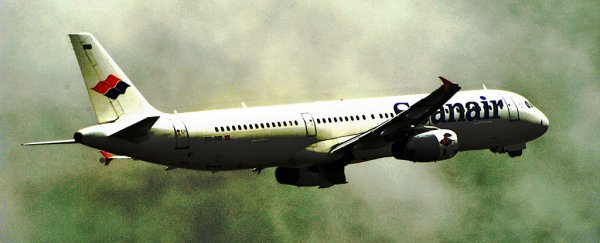If you've ever been on a plane, then there's a good chance you've been hit by turbulence: a sudden buffeting of the aircraft as it jumps up and down in a series of air pockets.
When you're experiencing turbulence, it can feel like it's about to bring the plane down any second – but it's actually not that dangerous at all, and if you know the science behind these mid-air jolts, it might help you relax a little during your next trip.
As Alana Schetzer explains over at Pursuit, turbulence can happen for many reasons - changes in atmospheric pressure; jet streams; the swirl of air around mountains; cold or warm weather fronts; thunderstorms. It can happen in the midst of thunderclouds, or when the sky appears to be clear.
But let's be clear: it can also be rough. And turbulence can cause injuries, especially if you're not obeying the seatbelt sign. But the chances of turbulence pulling a modern-day passenger jet out of the sky are virtually nil.
Firstly, despite what you might be seeing in the cabin, turbulence isn't having as big of an impact on the plane as you might think.
"Altitude, bank, and pitch will change only slightly during turbulence - in the cockpit we see just a twitch on the altimeter," writes Patrick Smith, pilot and author, on aviation website Ask The Pilot. "Conditions might be annoying and uncomfortable, but the plane is not going to crash."
Secondly, planes are specifically built to withstand even the most severe turbulence, and pilots are trained to deal with it.
You won't notice as a passenger, but pilots will often slow the plane slightly and may adjust the altitude to avoid turbulence. Most of the time, they'll just ride it out.
Meanwhile commercial aircraft are tested to extremes far beyond anything they'll ever encounter in the air (about 1.5 times the stress). It's likely that the wings attached to the next plane you fly in are capable of flexing up to 90 degrees.
In rough turbulence, you might get your drink spilled over you, but as far as the plane's safety is concerned, there's no need to panic.
For the past five years, the US Federal Aviation Administration (FAA) reports that an average of less than 50 injuries occur every year due to turbulence, and most of those were cabin crew who didn't have a chance to sit down and strap in. Not bad when around 800 million people fly in the US each year.
"Injuries caused by turbulence are very rare, and when it does happen, it's normally because people weren't wearing their seatbelts or they were walking around the cabin," atmospheric scientist Todd Lane, from the University of Melbourne in Australia, told Schetzer.
"Things like this create this perception that flying is unsafe, but it is very safe. It's more dangerous driving your car to the airport than actually flying," Lane explained.
The good news is that plane systems are getting better all the time at spotting changes in air pressure. Rather less encouraging is the news that increased levels of carbon dioxide in the air are thought to be causing more incidents of turbulence.
Basically, if you want to avoid a cut on the head from turbulence, always stay strapped in when you're sat down. And, if you can, sit over the wings, where you're closest to the plane's centre of lift and gravity, which will minimise the experience of turbulence as much as possible.
Happy flying, folks!
H/T: Alana Schetzer
